|
"High
Adventure:
The Pioneering Aerial Photographs of Mary Upjohn Meader"
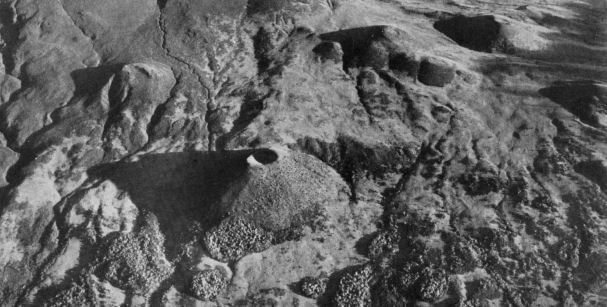 by
Monica Barnes
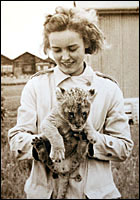 On
September 16, 1937, Mary Upjohn took off from Kalamazoo, Michigan. Still in her
20s, she was beginning a pioneering flight that brought her over three continents.
In the pilot's seat was her first husband, surgeon and future American Geographical
Society President Richard Upjohn Light (1902-1994). Mary was the co-pilot, radio
operator, and photographer. The goal was to make a record of South American and
African land forms, city plans, farms, mines, and industrial installations. On
September 16, 1937, Mary Upjohn took off from Kalamazoo, Michigan. Still in her
20s, she was beginning a pioneering flight that brought her over three continents.
In the pilot's seat was her first husband, surgeon and future American Geographical
Society President Richard Upjohn Light (1902-1994). Mary was the co-pilot, radio
operator, and photographer. The goal was to make a record of South American and
African land forms, city plans, farms, mines, and industrial installations.
Aerial photography was still relatively new in the late 1930s. Although photos
had been taken from balloons from the mid-nineteenth century, slow film and plates
and unreliable airships inhibited development until World War I, when photos taken
from the air became essential to military intelligence. During the 1920s and 30s
air photography progressed rapidly but many parts of the world had still not been
photographed from above.
Air passenger travel, air mail and air freight
had been launched in both South America and Africa by the late 1930s. This provided
an infrastructure of landing fields and basic aeronautical services. Fields were
small, unsurfaced, and usually lacked hangars. Frequently pilots were beyond radio
range and had no access to weather reports. When Richard and Mary landed at the
Kampala Airport on December 17, 1937, they were piloting only the third plane
to ever arrive there.
Throughout the 1930s the American Geographical
Society encouraged photographic flights over key parts of the planet, building
an archive of aerial views. Some of the best were published in their Focus
series of books, or in articles in their Geographical Review. Nevertheless,
many excellent photos remained unpublished, but are preserved in the Society's
library in Milwaukee, including those from the Meader-Light expedition. Professional
geographers David Dickason and Oscar Horst located Meader's contact prints a few
years ago and made digital enlargements. Her negatives have not been located.
Mary Meader's involvement in aerial photography had its roots in her husband's
previous expedition. Richard Light trained as a pilot in the U.S. Army Air Corps,
receiving his license in 1919. In 1935 he made an aerial transect of the northern
continents with a Yale classmate as photographer. Photos taken on that expedition
are also in the AGS Library. In 1937 Light was eager to complete his world tour
by exploring the southern continents.
Mary Upjohn terminated her studies
at Smith College to marry Richard Light. She did not, however, suspend her sense
of adventure and agreed to master the skills needed to fully participate in her
husband?s project. During the course of her aeronautical studies her first child
was born.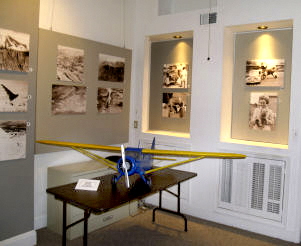
Mary
and Richard had the best equipment available. Their airplane was a Bellanca Skyrocket
powered by a single engine. It was designed to fly very long distances without
refueling. It was equipped with a Morse-code radio and a meager oxygen supply,
but was unpressurized and unheated. Mary had two cameras. One was a Fairchild
F8 aerial camera which used 5 x 7 inch roll film specially made and loaded by
Kodak. Mary's Fairchild is on permanent loan to the Air Zoo in Kalamazoo, Michigan.
She also had a 35 mm Leica.
Although the best of Mary's African photos
were published in Focus on Africa (1941) and have been exhibited at community
venues in her native Kalamazoo, only 27 of her Latin American views were published
in a 1946 issue of The Geographical Review. In October 2005 Mary's western
hemisphere photographs were first shown to the public at the Society of Woman
Geographers? International Headquarters, Washington, D.C. During the summer of
2006 they were on display, along with a selection of the African images, at the
Hudson Museum at the University of Maine, Orono. In the fall of that year the
exhibition was at Brazos Valley Museum of Natural History, Bryan, Texas. The University
of Kansas became the fourth venue in the fall of 2007. A set of Mary's prints
is on permanent display at the W.E. Upjohn Center for the Study of Geographical
Change at the University of Western Michigan.
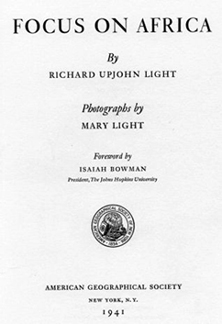 Mary's
South American flights are described in her unpublished diary. Copies are on deposit
in the libraries of the AGS and the U.S. Air Force Academy. Information on her
African flights appears in Focus on Africa. Mary worked under constraints
of time, money, fuel, and film. In most cases she literally had only one shot
and could not wait for ideal conditions. She took approximately 1,800 photographs. Mary's
South American flights are described in her unpublished diary. Copies are on deposit
in the libraries of the AGS and the U.S. Air Force Academy. Information on her
African flights appears in Focus on Africa. Mary worked under constraints
of time, money, fuel, and film. In most cases she literally had only one shot
and could not wait for ideal conditions. She took approximately 1,800 photographs.
In the 1930s national governments still tried to limit strategic knowledge
by restricting air photography. Richard and Mary had to secure advance permission
to take photographs, and this was not always granted. During many of their flights,
their cameras had to remain in their luggage compartment, in boxes sealed by customs.
Nevertheless, Mary took a few air and ground photos in the vicinity of Mexico
City as well as a limited number of shots of Guatemala from the air. When Mary
landed in Guatemala City her aerial camera was sealed until she reached Lima,
Peru. Photography was forbidden over the Central American republics, as well as
over Colombia and Ecuador. Once Mary was above northern Peru she was able to use
her Leica. In Lima Mary secured permission to use the Fairchild on her trip south
to Chile. Her photographs of the famous ancient Nazca lines are the earliest known.
In Chile Mary was permitted to take photos under air force supervision.
Mary was also allowed to work over Argentina, producing stunning city plan views
of Mendoza, Santa Fe, and Buenos Aires. Her cameras were sealed over Brazil. In
order to ship the Bellanca to Capetown, South Africa its wings were removed and
the partially disassembled plane was loaded onto the Arabia Maru. Mary
and Dick boarded that ship on November 6, 1937 to begin the next stage of their
journey.
Richard and Mary had permission to fly and photograph over British
East Africa. They plotted a route from south to north, beginning at Capetown,
and continuing to Johannesburg, and on to Dar es Salaam, Nairobi, Kampala, Malakal,
Luxor and Cairo. Notable among their photos are views of the Capetown, Lourenço
Marques (now Maputo) and Dar es Salaam harbors, the big hole of the Kimberley
diamond mines, Swazi, Zulu and Kavirondo kraals or villages with cattle enclosures,
Victoria Falls and the snows of Kilimanjaro when they were more extensive than
today. Mounts Kenya and Stanley, the old Aswan Dam and the Pyramids of Egypt surrounded
by irrigated fields with Cairo in the distance are also memorable images 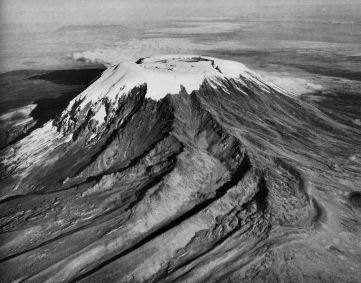 Mount
Kilimanjaro, the highest point in Africa Mount
Kilimanjaro, the highest point in Africa |
The
original plan was to turn east after arriving at Cairo, then fly over western
Asia, India, and southeast Asia. However, Mary was pregnant with her second son
and the combination of morning and air sickness became intolerable. The couple
decided to return home via North Africa. The French and Italian authorities who
controlled that territory did not allow them to take photos. In Corsica their
Bellanca was severely damaged in a storm while on the ground. Eventually it was
shipped to the States, repaired, and continued its flying career out of Long Island
Islip Airport. Mary and Richard returned to the United States by ship.
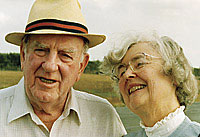 Once
back in Michigan Mary Meader devoted herself to family life. During her young
adult years she struggled with major depression. An heir to the Upjohn pharmaceutical
fortune, she, along with her second husband, the late Edwin E. Meader, have contributed
substantial sums of money to support research on that affliction. Once
back in Michigan Mary Meader devoted herself to family life. During her young
adult years she struggled with major depression. An heir to the Upjohn pharmaceutical
fortune, she, along with her second husband, the late Edwin E. Meader, have contributed
substantial sums of money to support research on that affliction.
Although
Mary maintained her pilot's license, she never participated in another project
like the South American and African transects. She has been a member of the exclusive
Society of Woman Geographers since 1942 and in 2005 she was honored with the Society's
Outstanding Achievement Award. In 2005 she also became an honorary fellow of the
American Geographical Society and has signed their Flyers and Explorers Globe,
an autographed record of outstanding flights, voyages, and treks. Her work is
featured in the Smithsonian's National Air and Space Museum "Women in Flight"
display. Recently, she and Edwin Meader established W.E. Upjohn Center for the
Study of Geographical Change at Western Michigan University. The Center includes
top-of-the-line, large format custom scanners dedicated to reproducing precious
and unique material such as maps and photographs. Although now too frail to travel,
Mary Upjohn Meader's skill, bravery, and
initiative continue to inspire. 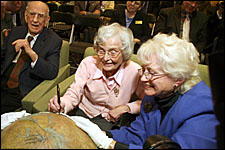 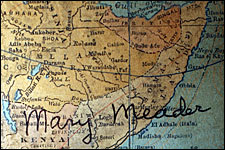
Mary
Meader: Another Pioneer Signs the AGS Globe, By
Mary Lynne Bird
On
November 21, 2006 a pioneer of aerial photography, Mary Meader, placed her signature
on the Fliers’ & Explorers’ Globe at a special ceremony in her
honor held at the Upjohn Center on the campus of Western
Michigan University
in Kalamazoo.
|
High
Adventure: The 1937-1938 Aerial Photographs of Mary Upjohn Meader
Developed
by: Monica Barnes, David Dickason and David Fleming
Organized by: Dr. Bill
Woods, Director of the University of Kansas Environmental Studies Program Mary
Upjohn Ariel Photography Exhibit Photos
www.amergeog.org/archives/meader/index.html
Meader exhibition at the University
of Kansas.
ttp://www.amergeog.org/archives/meader/index.html
Michigan
includes permanent display of the photos of Mary Meader.
http://www.csmgroup.com/sights/sights03_04.htm
Mary Meader’s
signing of A.G.S.’s Flyers’ and Explorers’ globe. http://www.wmich.edu/wmu/news/2006/11/059.html
"High
Adventure” opened at the Society of Women Geographers in October,
2005. It has also been displayed at the Hudson Museum of the University of Maine
in the summer of 2006 and at the Brazos Valley Museum of Natural History in the
fall of 2006 and the University of Kansas, 2007.
Mary
has been a member of the exclusive Society of Woman
Geographers since 1942.
Her work is featured in the Smithsonian’s National Air and Space Museum’s
“Women in Flight” display.
The American Geographical
Society
Celebrating 156 Years of Geographical Inquiry,
1851-2007
120 Wall Street, Suite 100, New York, NY 10005-3904
P (212) 422-5456,
F (212) 422-5480
WIPI wishes to thank Monica
Barnes for bringing our attention to Mary Upjohn Meader.
|


 On
September 16, 1937, Mary Upjohn took off from Kalamazoo, Michigan. Still in her
20s, she was beginning a pioneering flight that brought her over three continents.
In the pilot's seat was her first husband, surgeon and future American Geographical
Society President Richard Upjohn Light (1902-1994). Mary was the co-pilot, radio
operator, and photographer. The goal was to make a record of South American and
African land forms, city plans, farms, mines, and industrial installations.
On
September 16, 1937, Mary Upjohn took off from Kalamazoo, Michigan. Still in her
20s, she was beginning a pioneering flight that brought her over three continents.
In the pilot's seat was her first husband, surgeon and future American Geographical
Society President Richard Upjohn Light (1902-1994). Mary was the co-pilot, radio
operator, and photographer. The goal was to make a record of South American and
African land forms, city plans, farms, mines, and industrial installations.
 Mary's
South American flights are described in her unpublished diary. Copies are on deposit
in the libraries of the AGS and the U.S. Air Force Academy. Information on her
African flights appears in Focus on Africa. Mary worked under constraints
of time, money, fuel, and film. In most cases she literally had only one shot
and could not wait for ideal conditions. She took approximately 1,800 photographs.
Mary's
South American flights are described in her unpublished diary. Copies are on deposit
in the libraries of the AGS and the U.S. Air Force Academy. Information on her
African flights appears in Focus on Africa. Mary worked under constraints
of time, money, fuel, and film. In most cases she literally had only one shot
and could not wait for ideal conditions. She took approximately 1,800 photographs.

 Once
back in Michigan Mary Meader devoted herself to family life. During her young
adult years she struggled with major depression. An heir to the Upjohn pharmaceutical
fortune, she, along with her second husband, the late Edwin E. Meader, have contributed
substantial sums of money to support research on that affliction.
Once
back in Michigan Mary Meader devoted herself to family life. During her young
adult years she struggled with major depression. An heir to the Upjohn pharmaceutical
fortune, she, along with her second husband, the late Edwin E. Meader, have contributed
substantial sums of money to support research on that affliction. 
